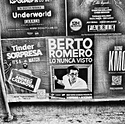Nodda Duma
Member
I performed an interesting experiment where I contact printed a negative onto a silver gelatin emulsion coated piece of glass by placing it in the sun for many months. The experiment could have been performed with paper or film but I happened to use one of my dry plates.
This weekend I processed the plate by fixing it with no use of developer. The result was pretty cool but the question is... why was there any image at all? Even through the dense parts of the negative, the plate received plenty of sunlight. One would think the density would have leveled out to the same amount regardless of shadows or highlights.
Shown are scans of the results and the original negative, and a photo of the plate itself.



This weekend I processed the plate by fixing it with no use of developer. The result was pretty cool but the question is... why was there any image at all? Even through the dense parts of the negative, the plate received plenty of sunlight. One would think the density would have leveled out to the same amount regardless of shadows or highlights.
Shown are scans of the results and the original negative, and a photo of the plate itself.











